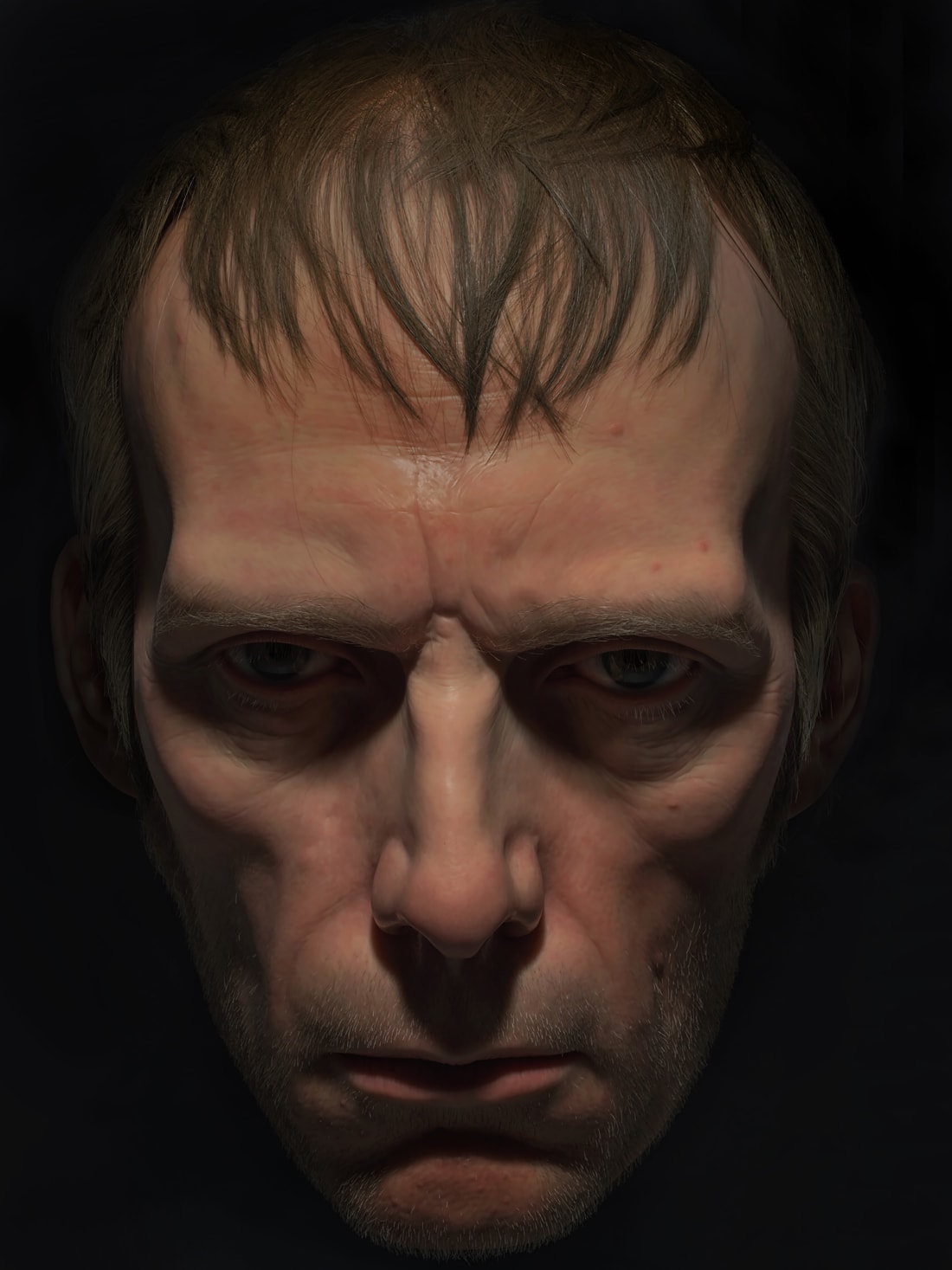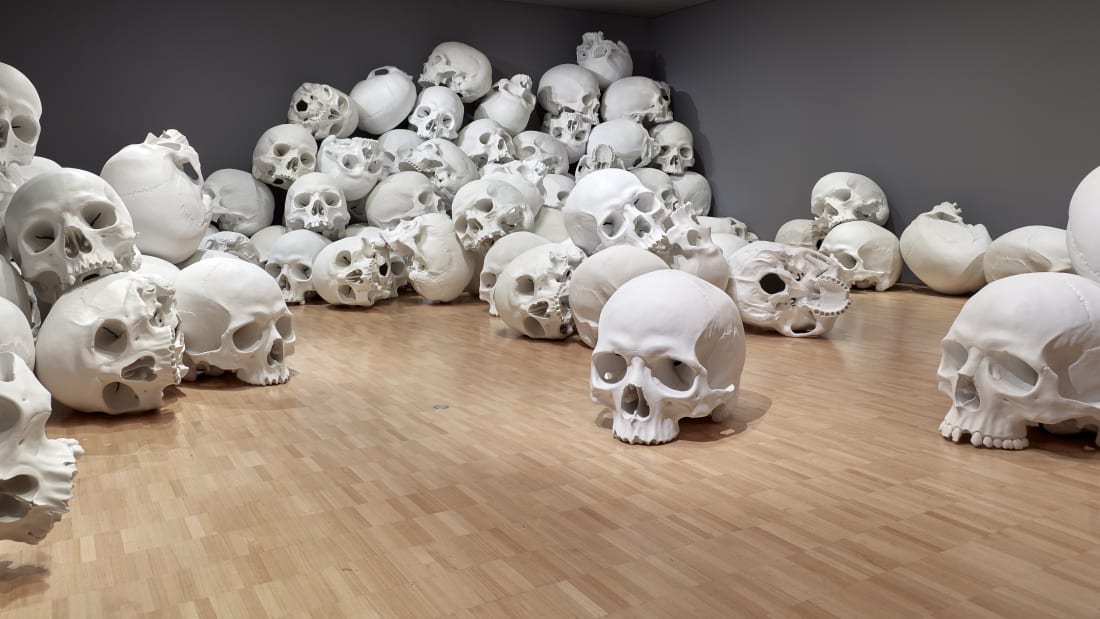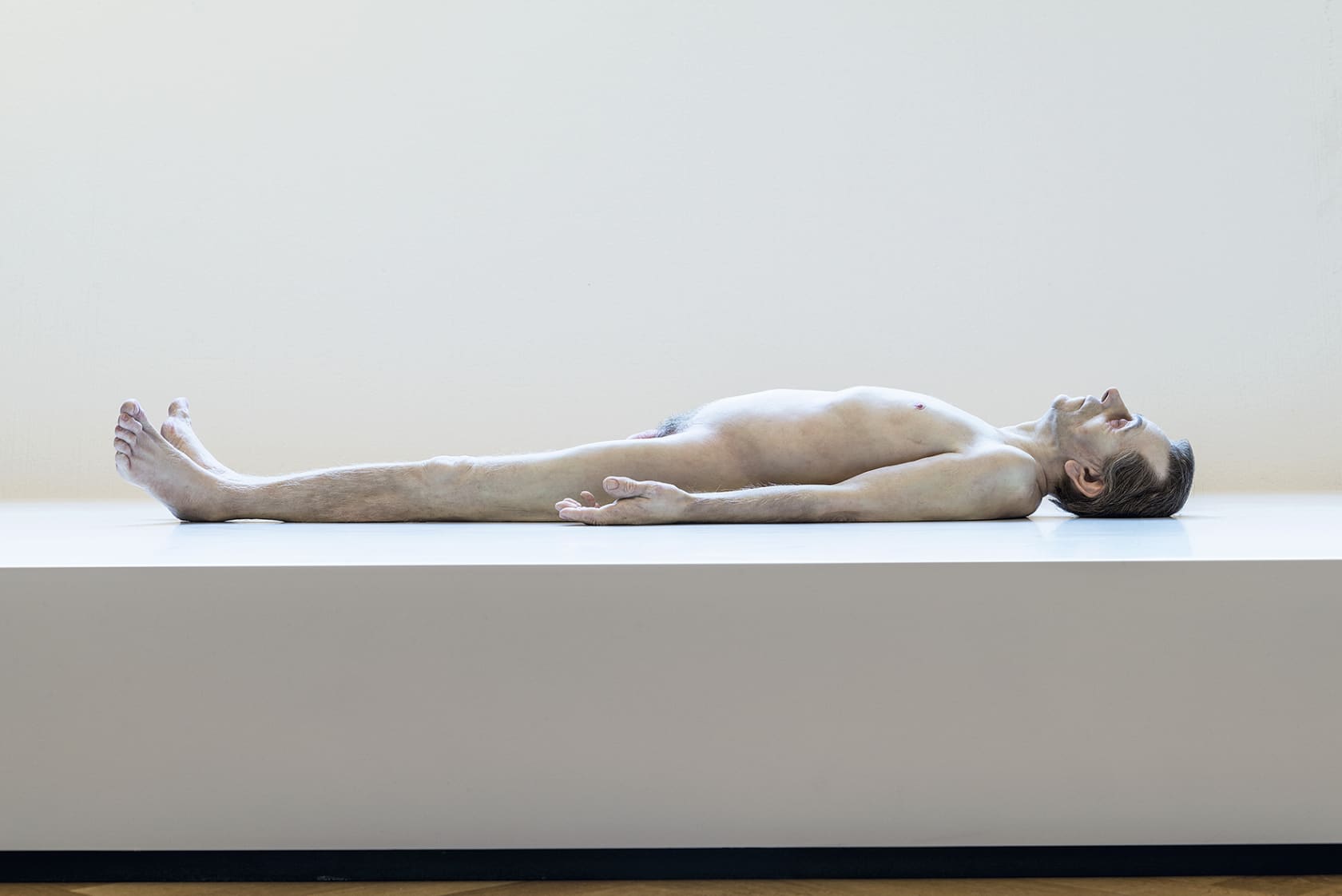
Ron Mueck Dead Dad, 1996–97
Dead Dad is one of Mueck’s earliest and most significant works, first shown in the legendary exhibition Sensation: Young British Artists from the Saatchi Collection at London’s Royal Academy of Arts in 1997. ‘Of the 110 exhibits by some of Britain’s best-known contemporary artists, it was this work [...] that drew excited attention and enthusiastic responses from the public,’ recalls David Hurlston. ‘What made the piece so compelling was that it was at once astounding in its apparent realism and truly poignant in its humility and vulnerability’ (Hurlston, 2011, p. 19). Having begun his career in film and television, Mueck had only recently dedicated himself to fine art. This sculpture was lauded as the star of the show, which was instrumental in establishing him as one of the most important artists of his generation.
The pathos of Dead Dad is heightened by its uncannily lifelike and yet lifeless quality. While the subject recalls art-historical references such as the crucifixion, there is nothing heroic about Mueck’s depiction of death. Instead, his father figure is undeniably human, even pitiable, with its ‘obsessive truth to anatomical detail, from wizened face to limp genitals to splayed feet, and its replication of the stiffened posture of rigor mortis’ (Rosenblum, 2005, p. 46). This painstaking fidelity to detail creates a sense of intimacy through close examination, lending the work the powerful aura of a reliquary or votive object commemorating the dead.
Scale is one of the key psychological tools that Mueck uses in his work. Despite their extraordinarily lifelike appearance, his figures are always smaller or larger than life-size and removed to their own realm by these deviations from reality. The artist has often been quoted as saying that Dead Dad’s size is such that one could pick him up and cradle him, while the reduction in scale also intensifies the sense of loss. The emphasis is upon dying as an irreversible process of diminution, with the lifeless parent no longer looming large in relation to the child, who now becomes head of the family with all of the responsibilities that entails.
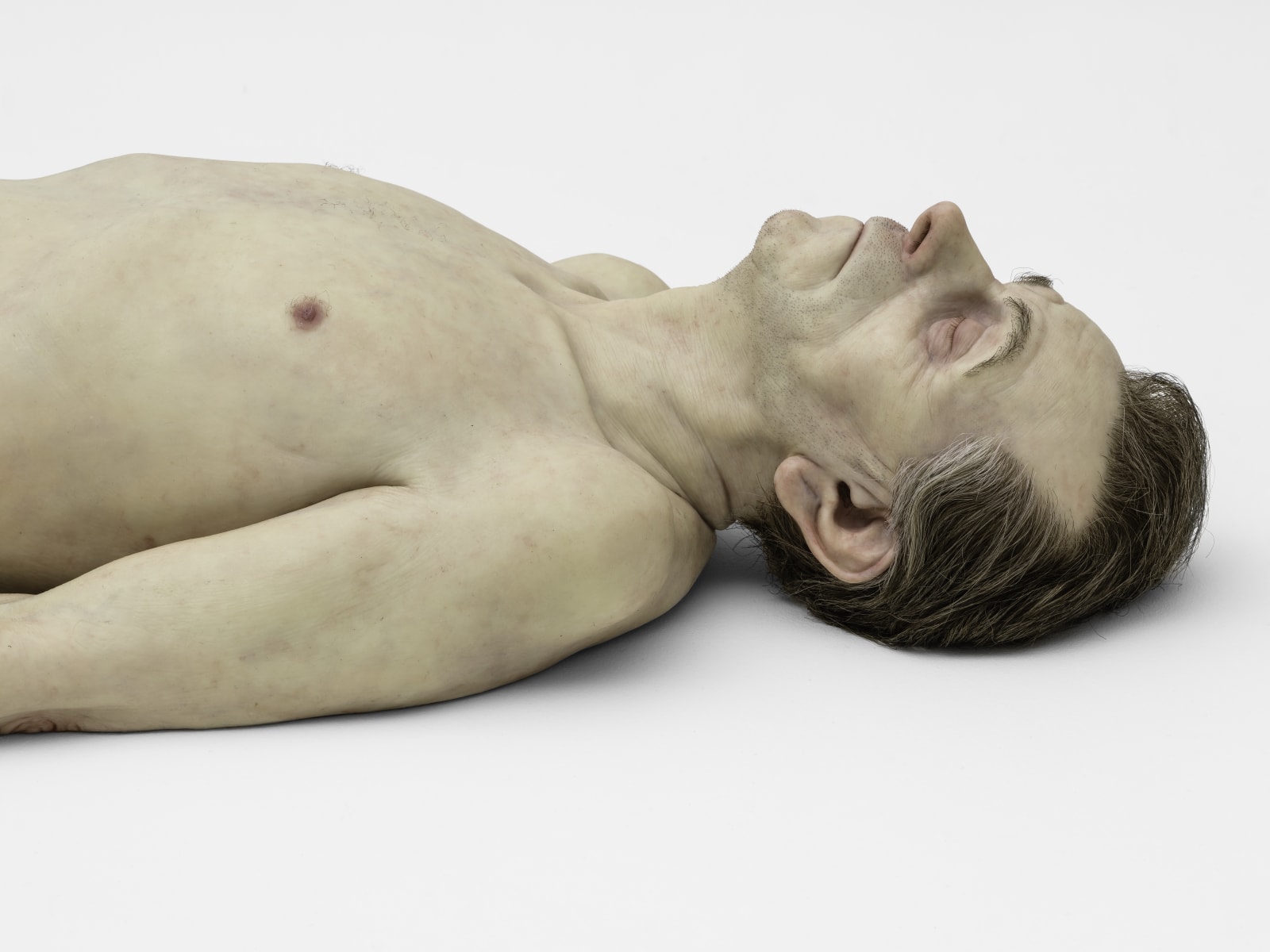
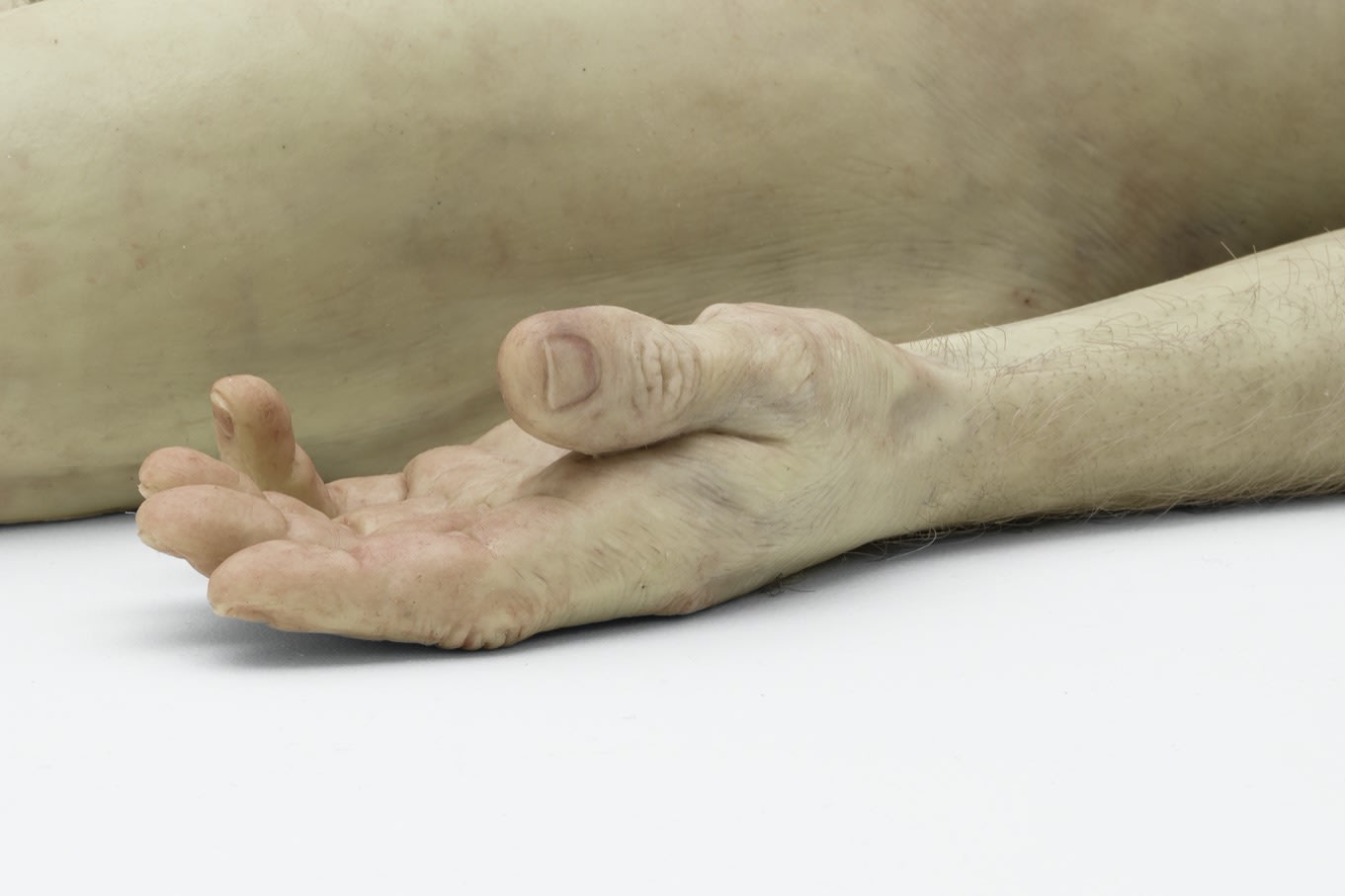
More works by 론 뮤엑
현재 전시 둘러보기

작가
-
코리 아크앤젤
-
쥘 드 발랭쿠르
-
슈테판 발켄홀
-
알리 바니사드르
-
미구엘 바르셀로
-
알바로 베링턴
-
게오르그 바젤리츠
-
올리버 비어
-
요셉 보이스 재단
-
마크 브랜든버그
-
리사 브라이스
-
장-마크 뷰스트망트
-
조던 카스틸
-
정희민
-
토니 크랙
-
리처드 디콘
-
마르셀 뒤샹
-
맨디 엘-사예
-
발리 엑스포트
-
하룬 파로키 재단
-
실비 플뢰리
-
아드리안 게니
-
길버트와 조지
-
아모스 지타이
-
안토니 곰리
-
한빙
-
코리 아크앤젤
-
쥘 드 발랭쿠르
-
슈테판 발켄홀
-
알리 바니사드르
-
미구엘 바르셀로
-
알바로 베링턴
-
게오르그 바젤리츠
-
올리버 비어
-
요셉 보이스 재단
-
마크 브랜든버그
-
리사 브라이스
-
장-마크 뷰스트망트
-
조던 카스틸
-
정희민
-
토니 크랙
-
리처드 디콘
-
마르셀 뒤샹
-
맨디 엘-사예
-
발리 엑스포트
-
하룬 파로키 재단
-
실비 플뢰리
-
아드리안 게니
-
길버트와 조지
-
아모스 지타이
-
안토니 곰리
-
한빙
-
한스 요셉손 재단
-
도널드 저드 재단
-
마르타 융비르트
-
일리야 & 에밀리아 카바코프
-
이강소
-
알렉스 카츠
-
안젤름 키퍼
-
이미 크뇌벨
-
울프강 라이프
-
조나단 라스커
-
로이 리히텐슈타인
-
로버트 롱고
-
라이자 루
-
막신 마시요브스키
-
로버트 메이플소프 재단
-
제이슨 마틴
-
비야네 멜고르
-
베라 몰나르
-
론 뮤엑
-
패트릭 노이
-
닉 오베르탈러
-
에바 헬렌 파데
-
어빙 펜 재단
-
엘리자베스 페이튼
-
잭 피어슨
-
로나 폰딕
-
임란 쿠레쉬
-
아르눌프 라이너
-
로버트 라우센버그 재단
-
다니엘 리히터
-
게발드 로켄쇼브
-
메간 루니
-
제임스 로젠퀴스트 재단
-
톰 삭스
-
데이비드 살레
-
마르쿠스 쉰발트
-
션 스컬리
-
라킵 쇼
-
안드레아 슬로민스키
-
조안 스나이더
-
스터티번트 재단
-
에밀리오 베도바 재단
-
뱅크스 바이올렛
-
낫 바이탈
-
앤디 워홀
-
로렌스 와이너
-
로버트 윌슨
-
에르빈 부름
-
제이디 차
-
얀 페이밍
Cookies allow us to provide you with useful features and to measure performance in order to improve your experience. By clicking 'Accept all', you agree to the use of all cookies. By clicking 'Manage Cookies', you only agree to the use of selected cookie categories. For more information, see our Privacy Policy.
Your shopping bag
Get exclusive updates from Thaddaeus Ropac
Sign up for updates
We'll be in touch with you shortly
-
코리 아크앤젤
-
쥘 드 발랭쿠르
-
슈테판 발켄홀
-
알리 바니사드르
-
미구엘 바르셀로
-
알바로 베링턴
-
게오르그 바젤리츠
-
올리버 비어
-
요셉 보이스 재단
-
마크 브랜든버그
-
리사 브라이스
-
장-마크 뷰스트망트
-
조던 카스틸
-
정희민
-
토니 크랙
-
리처드 디콘
-
마르셀 뒤샹
-
맨디 엘-사예
-
발리 엑스포트
-
하룬 파로키 재단
-
실비 플뢰리
-
아드리안 게니
-
길버트와 조지
-
아모스 지타이
-
안토니 곰리
-
한빙
-
한스 요셉손 재단
-
도널드 저드 재단
-
마르타 융비르트
-
일리야 & 에밀리아 카바코프
-
이강소
-
알렉스 카츠
-
안젤름 키퍼
-
이미 크뇌벨
-
울프강 라이프
-
조나단 라스커
-
로이 리히텐슈타인
-
로버트 롱고
-
라이자 루
-
막신 마시요브스키
-
로버트 메이플소프 재단
-
제이슨 마틴
-
비야네 멜고르
-
베라 몰나르
-
론 뮤엑
-
패트릭 노이
-
닉 오베르탈러
-
에바 헬렌 파데
-
어빙 펜 재단
-
엘리자베스 페이튼
-
잭 피어슨
-
로나 폰딕
-
임란 쿠레쉬
-
아르눌프 라이너
-
로버트 라우센버그 재단
-
다니엘 리히터
-
게발드 로켄쇼브
-
메간 루니
-
제임스 로젠퀴스트 재단
-
톰 삭스
-
데이비드 살레
-
마르쿠스 쉰발트
-
션 스컬리
-
라킵 쇼
-
안드레아 슬로민스키
-
조안 스나이더
-
스터티번트 재단
-
에밀리오 베도바 재단
-
뱅크스 바이올렛
-
낫 바이탈
-
앤디 워홀
-
로렌스 와이너
-
로버트 윌슨
-
에르빈 부름
-
제이디 차
-
얀 페이밍








